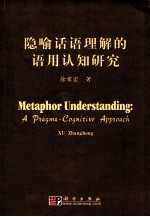

隐喻话语理解的语用认知研究PDF电子书下载
- 电子书积分:10 积分如何计算积分?
- 作 者:徐章宏著
- 出 版 社:北京:科学出版社
- 出版年份:2007
- ISBN:7030182081
- 页数:212 页
Chapter 1 General Introduction 1
1.0 Brief introduction to metaphor studies 1
1.1 Rationale of this research 4
1.2 Purposes of this research 8
1.3 Novel metaphor:target of research 12
1.3.1 Linguistic analysis oftarget data 13
1.3.2 Definition of target data 15
1.4 Methodology for this research 19
1.5 Overview of the thesis 20
Chapter 2 Literature Review of Related Studies 22
2.0 Introduction 22
2.1 Cognitive approaches to metaphor 23
2.1.1 Black's cognitive approach to metaphor 24
2.1.2 Lakoff et al.'s cognitive-semantic approach to metaphor 29
2.1.3 Conceptual blending/integration-based approach metaphor 33
2.1.4 Brief summary 36
2.2 Pragmatic-cognitive approaches to metaphor understanding 37
2.2.1 Grice'sconception of metaphor as an implicature 37
2.2.2 Searle's approach to metaphor as an indirect speech act 37
2.2.3 Brief summary 39
2.2.4 S&W's pragma-cognitive approach to metaphor 41
2.3 Process-oriented studies of metaphor understanding 42
2.3.1 Salience-imbalance model of metaphor understanding 42
2.3.2 Structure-mapping model of metaphor understanding 43
2.3.3 Domains-interaction model of metaphor understanding 45
2.3.4 Class-inclusion model of metaphor understanding 47
2.3.5 Brief summary 49
2.4 Evaluation and comments of reviewed theories/models 50
2.4.1 Respecting the long cognitive tradition of metaphor research 50
2.4.2 Weakening the strong claims about metaphoric thought and language 51
2.4.3 The danger of scientific reductionism in theories of metaphor 53
2.4.4 Reasons for adopting a pragrna-cognitive approach to metaphor study 53
Chapter 3 A Relevance-Theoretic Framework to Metaphor Understanding 56
3.0 Introduction 56
3.1 Metaphor as representation by resemblance 58
3.1.1 Descriptive and interpretive dimensions of language use 58
3.1.2 Metaphor as a descriptive use of language 62
3.1.3 Metaphor as effort-imposing loose talk 64
3.2 Basic notions concerning metaphorical understanding 66
3.2.1 Mutual manifest-ness:the prerequisite for metaphor understanding 66
3.2.2 Optimal relevance:the ultimate goal of metaphor understanding 69
3.3 Metaphor interpretation 72
3.3.1 Explicatures of metaphorical utterances 72
3.3.2 Metaphor as a weak implicature 76
3.4 Characterization of the conceptual framework to metaphor understanding 83
3.4.1 Metaphor understanding involves three sub-processes 83
3.4.2 Metaphor understanding is effort-imposing 84
3.5 Summary 84
Chapter 4 Metaphoricity and Metaphorization 86
4.0 Introduction 86
4.1 The notion of metaphoricity 87
4.2 Metaphor as a re-conceptualization of entities 89
4.2.1 Metaphorization:theory-based rather than similari-ty-based 91
4.2.2 Ad hoc construction of'theories'governed by the principle of relevance 93
4.3 Metaphorization and de-metaphorization 97
4.3.1 Meaning construction:the issue of creativity of metaphor 97
4.3.2 Dynamics of metaphorization 100
4.4 Proposed criteria for metaphoricity identification 101
4.4.1 Two referential criteria of metaphoricity identifica-tion 102
4.4.2 Proposed criteria of metaphoricity identification 106
4.5 Metaphoricty judgments:an empirical study 109
4.6 Summary 111
Chapter 5 A Cognitive Process of Novel Metaphor Understanding 113
5.0 Introduction 113
5.1 Representational assumptions about Topic and Vehicle domains 113
5.1.1 Topic and Vehicle as schemas 114
5.1.2 Topic and Vehicle asimages 117
5.2 Metaphor understanding:identification of explica-tures 120
5.3 Metaphor understanding:construction of contextual assumptions 121
5.3.1 Constraints on context construction in metaphor understanding 122
5.3.2 Accessibility of contextual assumptions 130
5.4 Metaphor understanding:constructing implicatures 134
5.4.1 Implicature recovery involving non-demonstrative bridging inferences 134
5.4.2 Mutual adjustment and emergent structures 139
5.5 Heuristics for the choice of possible interpretations 141
5.6 Atentativerelevance-oriented model of metaphor understanding 143
5.7 Summary 145
Chapter 6 Novel Metaphor and Processing Effort 147
6.0 Introduction 147
6.1 Controversies on the issue of'metaphor and effort' 148
6.2 Novelmetaphor understanding as an effort-demanding task 151
6.2.1 'Suppression'in metaphor understanding involving more efforts 151
6.2.2 Emergents generation in metaphor understanding involving more effort 153
6.3 Rationale of the hypothesis about'metaphor and efforts' 155
6.3.1 Extra processing effort implies extra cognitive effect 155
6.3.2 Weak relevance presupposes extra processing effort 157
6.3.3 Brief summary 158
6.4 The experiment 159
6.4.1 Hypothesis of the experiment 159
6.4.2 Experiment on metaphor interpretation difficulty 160
6.5 ummary 171
Chapter 7 Conclusions and Implications 173
7.0 Introduction 173
7.1 Brief summary of major findings 173
7.2 Implications 178
7.2.1 Metaphor understanding involves both social and cognitive factors 178
7.2.2 Inevitability of misunderstandings in verbal communication 179
7.2.3 Theimportance of individual differences in utterance understanding 180
7.2.4 Challenge to contemporary metaphor theory's major claims 181
7.2.5 Some other implications 182
7.3 Suggestions for further studies 184
7.3.1 A more elaborated on-line experimental design might be worked out 184
7.3.2 Individual differences in metaphor processing should be considered 185
7.3.3 Speaker-related factors should be considered 186
7.3.4 The relationships between metaphor and'affect'merit further exploration 186
Appendix 189
Bibliography 200
- 《法语词汇认知联想记忆法》刘莲编著 2020
- 《你的话语是我沉默中开出的花朵》(法)安东尼·帕耶著 2019
- 《近代以来中国大众话语的生成与流变》罗崇宏著 2019
- 《模型与认知》(美)乔纳森·A.瓦斯肯著,魏刘伟译 2019
- 《现代汉语语用否定研究》王志英 2019
- 《认知语言学视野的抽象方位结构研究》曹爽著 2019
- 《现代南方民族文学话语研究》(中国)吴道毅 2019
- 《认知破局》王达著 2019
- 《计算机自适应英语语用能力测试系统设计与效度验证 以TEM4词汇与语法题为例》张一鑫著 2019
- 《牛津中国心理学手册 上 认知与学习》(美)迈克尔·哈里斯·邦德主编;赵俊华,张春妹译 2019
- 《NLP英语教学法》成宇宏著 2019
- 《水浒解“毒”》郭相宏著 2019
- 《愿你慢慢长大 爸爸写给女儿的二十封信》李映宏著 2019
- 《读红楼·学管理》李谋宏著 2019
- 《话有引力》(日)美浓部达宏著;夏言译 2020
- 《还原素描古典美》(日)卯野和宏著 2019
- 《PYTHON极简讲义 一本书入门数据分析与机器学习》张玉宏著 2020
- 《从情景关系看唐宋词境的流变》魏学宏著 2018
- 《汽车机修工快速上岗全程图解》(中国)汪立亮,章宏 2019
- 《湖北通史·宋元卷》王瑞明,雷家宏著 1999
- 《指向核心素养 北京十一学校名师教学设计 英语 七年级 上 配人教版》周志英总主编 2019
- 《《走近科学》精选丛书 中国UFO悬案调查》郭之文 2019
- 《北京生态环境保护》《北京环境保护丛书》编委会编著 2018
- 《中医骨伤科学》赵文海,张俐,温建民著 2017
- 《美国小学分级阅读 二级D 地球科学&物质科学》本书编委会 2016
- 《指向核心素养 北京十一学校名师教学设计 英语 九年级 上 配人教版》周志英总主编 2019
- 《强磁场下的基础科学问题》中国科学院编 2020
- 《小牛顿科学故事馆 进化论的故事》小牛顿科学教育公司编辑团队 2018
- 《小牛顿科学故事馆 医学的故事》小牛顿科学教育公司编辑团队 2018
- 《高等院校旅游专业系列教材 旅游企业岗位培训系列教材 新编北京导游英语》杨昆,鄢莉,谭明华 2019
